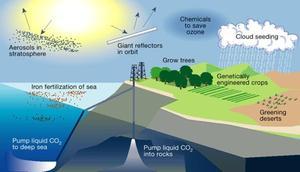Infrastructure protectionRelying on geoengineering to reduce climate change unlikely to succeed
Reducing the amount of sunlight reaching the planet’s surface by geoengineering may not undo climate change after all. Researchers used a simple energy balance analysis to explain how the Earth’s water cycle responds differently to heating by sunlight than it does to warming due to a stronger atmospheric greenhouse effect. Further, they show that this difference implies that reflecting sunlight to reduce temperatures may have unwanted effects on the Earth’s rainfall patterns.

A variety of geoengineering methods // Source: ataplaut.wordpress.com
Reducing the amount of sunlight reaching the planet’s surface by geoengineering may not undo climate change after all. Two German researchers used a simple energy balance analysis to explain how the Earth’s water cycle responds differently to heating by sunlight than it does to warming due to a stronger atmospheric greenhouse effect. Further, they show that this difference implies that reflecting sunlight to reduce temperatures may have unwanted effects on the Earth’s rainfall patterns.
The results are now published in Earth System Dynamics, a journal of the European Geosciences Union (EGU).
An EGU release reports that global warming alters the Earth’s water cycle since more water evaporates to the air as temperatures increase. Increased evaporation can dry out some regions while, at the same time, result in more rain falling in other areas due to the excess moisture in the atmosphere. The more water evaporates per degree of warming, the stronger the influence of increasing temperature on the water cycle. The new study shows, however, that the water cycle does not react the same way to different types of warming.
Axel Kleidon and Maik Renner of the Max Planck Institute for Biogeochemistry in Jena, Germany, used a simple energy balance model to determine how sensitive the water cycle is to an increase in surface temperature due to a stronger greenhouse effect and to an increase in solar radiation. They predicted the response of the water cycle for the two cases and found that, in the former, evaporation increases by 2 percent per degree of warming while in the latter this number reaches 3 percent. This prediction confirmed results of much more complex climate models.
“These different responses to surface heating are easy to explain,” says Kleidon, who uses a pot on the kitchen stove as an analogy. “The temperature in the pot is increased by putting on a lid or by turning up the heat – but these two cases differ by how much energy flows through the pot,” he says. A stronger greenhouse effect puts a thicker ‘lid’ over the Earth’s surface but, if there is no additional sunlight (if we don’t turn up the heat on the stove), extra evaporation takes place solely due to the increase in temperature. Turning up the heat by increasing solar radiation, on the other hand, enhances the energy flow through the Earth’s surface because of the need to balance the greater energy input with stronger cooling fluxes from the surface. As a result, there is more evaporation and a stronger effect on the water cycle.
In the new Earth System Dynamics study the authors also show how these findings can have profound consequences for geoengineering. Many geoengineering approaches aim to reduce global warming by reducing the amount of sunlight reaching the Earth’s surface (or, in the pot analogy, reduce the heat from the stove). When Kleidon and Renner applied their results to such a geoengineering scenario, however, they found out that simultaneous changes in the water cycle and the atmosphere cannot be compensated for at the same time. Therefore, reflecting sunlight by geoengineering is unlikely to restore the planet’s original climate.
“It’s like putting a lid on the pot and turning down the heat at the same time,” explains Kleidon. “While in the kitchen you can reduce your energy bill by doing so, in the Earth system this slows down the water cycle with wide-ranging potential consequences,” he says.
The release notes that Kleidon and Renner’s insight comes from looking at the processes that heat and cool the Earth’s surface and how they change when the surface warms. Evaporation from the surface plays a key role, but the researchers also took into account how the evaporated water is transported into the atmosphere. They combined simple energy balance considerations with a physical assumption for the way water vapour is transported, and separated the contributions of surface heating from solar radiation and from increased greenhouse gases in the atmosphere to obtain the two sensitivities. One of the referees for the paper commented: “it is a stunning result that such a simple analysis yields the same results as the climate models.”
— Read more in A. Kleidon Nd M Renner, “A simple explanation for the sensitivity of the hydrologic cycle to surface temperature and solar radiation and its implications for global climate change,” Earth System Dynamics 4 (2013): 455-65 (doi:10.5194/esd-4-455-2013)
